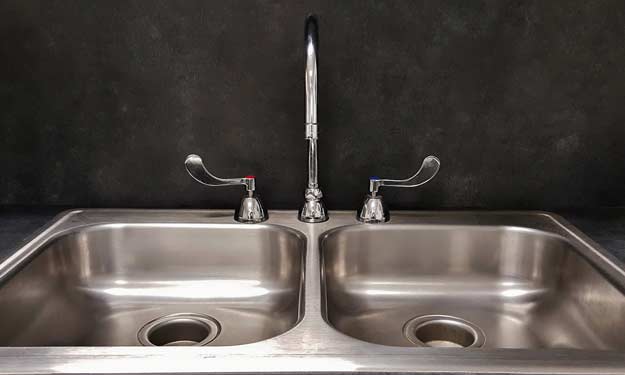Cleaning Stainless Steel Sinks

Cleaning a Stainless Steel Sink
Stainless steel is very durable, it’s resistant to blemishes, discoloration and other imperfections. Does that mean it’s resistant to stains and scratching? No, just like most any other, it will get scratched and it will stain. But if a scratch happens and cleaned correct, those scratches can become less obvious over time.
Stains will also happen and just like other surfaces, a spill or mess should be wiped up as soon as possible and not left to sit. But fortunately it’s possible to minimize wear and tear.
There’s a couple rules when it comes to keeping them clean and bright. Follow these cleaning tips from professional house cleaners at Mrs. Clean and shine and remove stains from your sinks for good!
How NOT to Clean a Stainless Steel Sink
- Don’t use Cleaners with Bleach: Regular bleach whether it’s straight from the bottle or included in cleaning products like comet with bleach will stain stainless steel because of a chemical reaction from the metal and the bleach. Stainless steel oxidizes and a gray or gold stain will be the unfortunate result.
- Don’t use Abrasive Cleaners: Stainless steel sinks have a polished finish. It will scratch and show scrapes if they are cleaned out with gritty/abrasive cleaning products. Always scrub with the grain when cleaning.
- Don’t use Steel Wool or Brushes: Just like using abrasive cleaning products, steel wool or steel bristle brushes will scratch the the sink deeply and permanently.
Every Day Sink Cleaning
With kids and three full meals a day, our sink gets it fair share of use. So at the end of the day, I’ll give it a quick clean. Fill the sink with hot water and add a squirt or two of your favorite dishwashing liquid. I like to use dawn dishwashing soap. It’s cheap and does a great job on grease.
When the sink is about 1/3 to 1/2 full, turn off the water and use your nylon brush or scrubber side of a sponge and scrub each side of the sink- don’t forget the bottom. When you have scrubbed each side thoroughly, empty the water from the sink.
Get your scrubber again and clean out the drain area making sure to remove the gunky build up that’s trapped there. Build up in the drain can cause odors and is frequently overlooked. The drain area should shine too. Rinse the sink completely with cold water and dry with a microfiber cloth.
When cleaning, scrub in the same direction as the polished grain. Scrubbing against the grain will scratch the highly polished finish. Make sure to rinse the sink completely to remove all cleaning agents. You can disinfect and further deodorize the sink by pouring plain white vinegar on a clean paper towel and wiping all sides.
Heavy Duty Sink Cleaning
If there is food items or oil adhering to the sink, dust a little baking soda inside it and then scrub it with a soft wet sponge. Baking soda is a deodorizer and mild abrasive. Remember to scrub lightly and with the grain. Your sink will sparkle when you’re finished.
Scratched and Stained Stainless Steel Sinks
Clean the sink using the heavy duty cleaning process I have outlined and then pick up a stainless steel polisher and conditioner. I like Cerama but there are other products like Scratch-B-Gone that work as well. It doesn’t remove scratching completely but it will help hide them and make the stainless look much less worn.
Barkeepers Friend is a good option for light cleanings.
Shining Stainless Steel
All types of stainless steel appliances shine up well with a bit of baby oil. Pour a little of the oil on a paper towel and wipe the sink. Don’t overdo the amount of oil used. The smallest amount will make the stainless shine the best. Wipe off excess oil with a soft cloth when finished.

